Abstract
The present review summarizes the current state of knowledge about the genetics of pain-related phenomena and illustrates the scope and power of genetic approaches to the study of pain. We focus on work performed in our laboratories in Jastrzebiec, Poland; Portland, OR; and Los Angeles, which we feel demonstrates the continuing usefulness of classical genetic approaches, especially when used in combination with newly available molecular genetic techniques.
Full text
PDF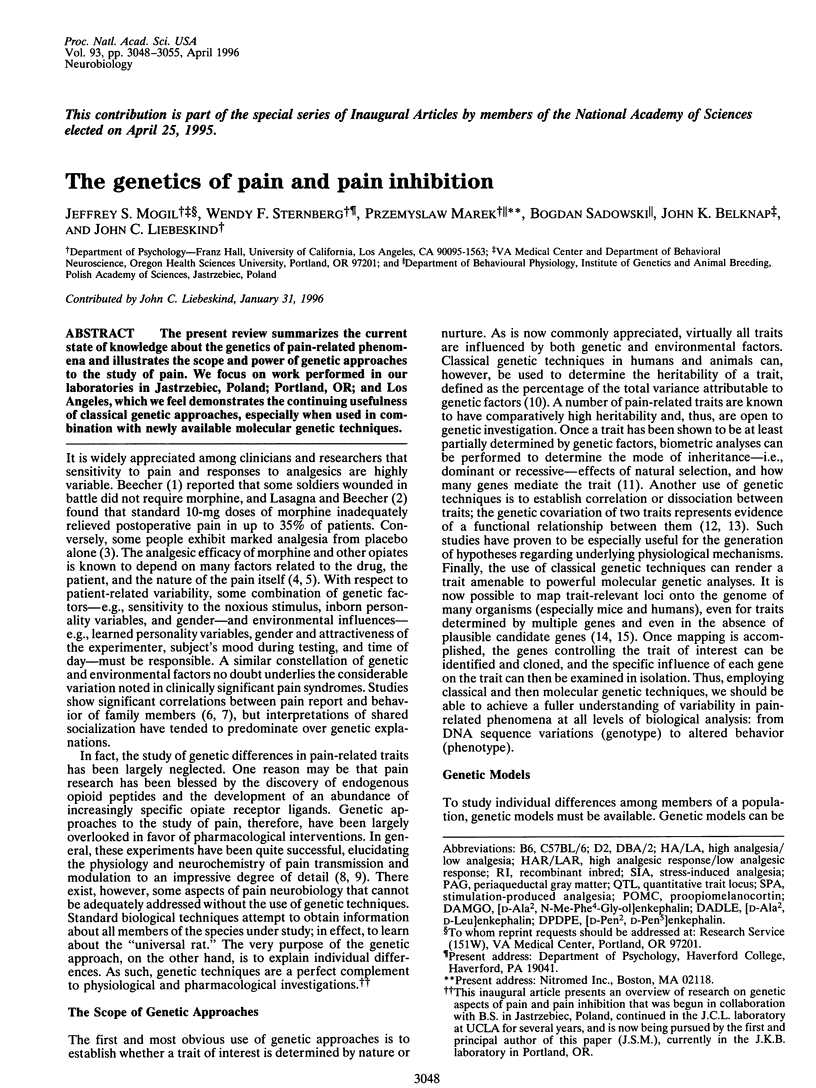
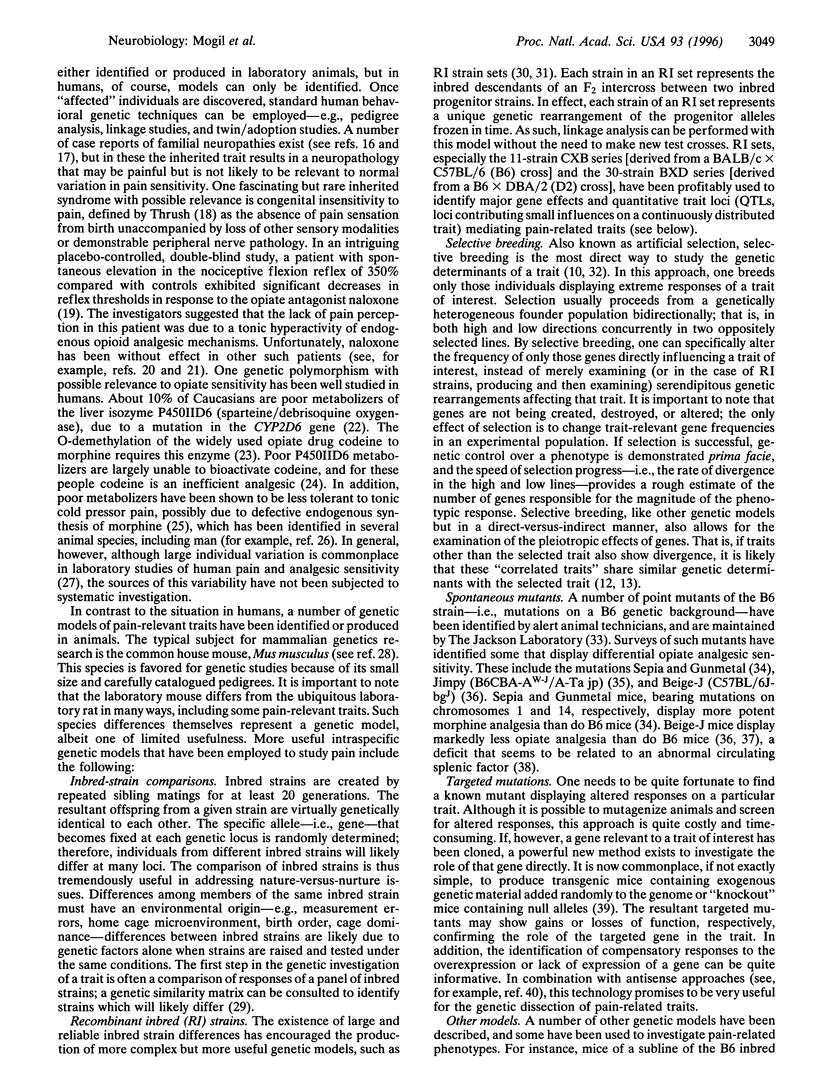

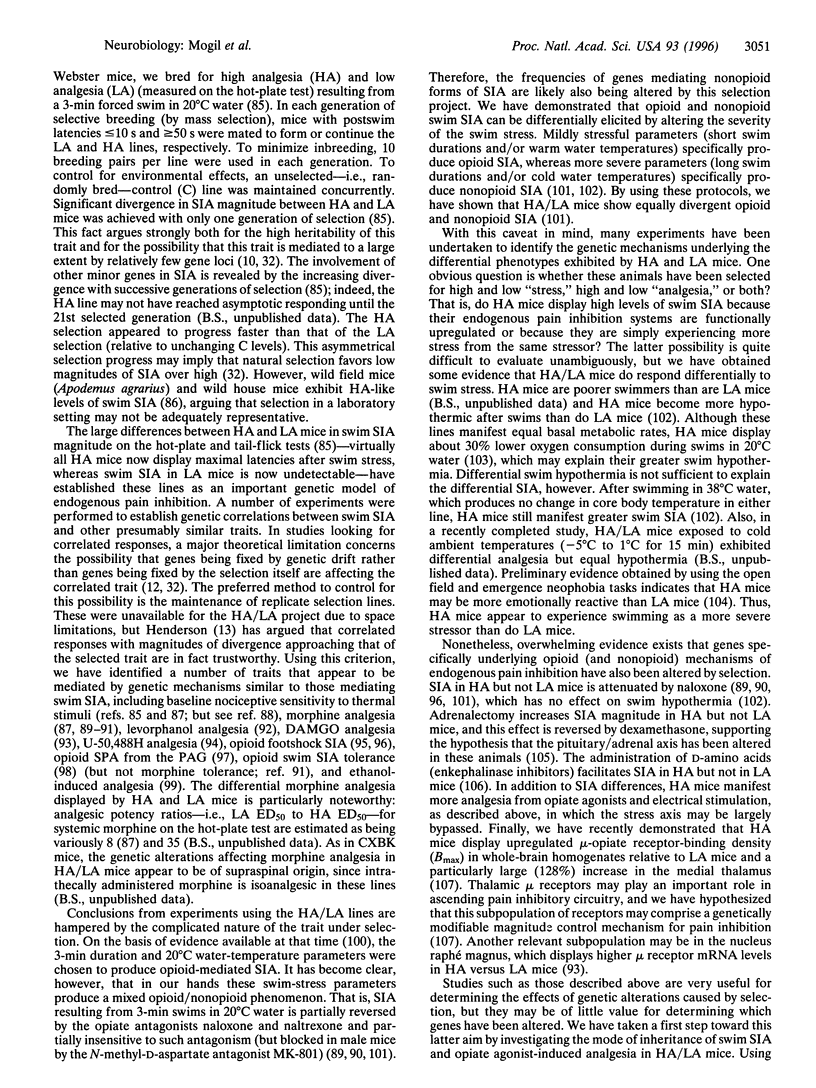
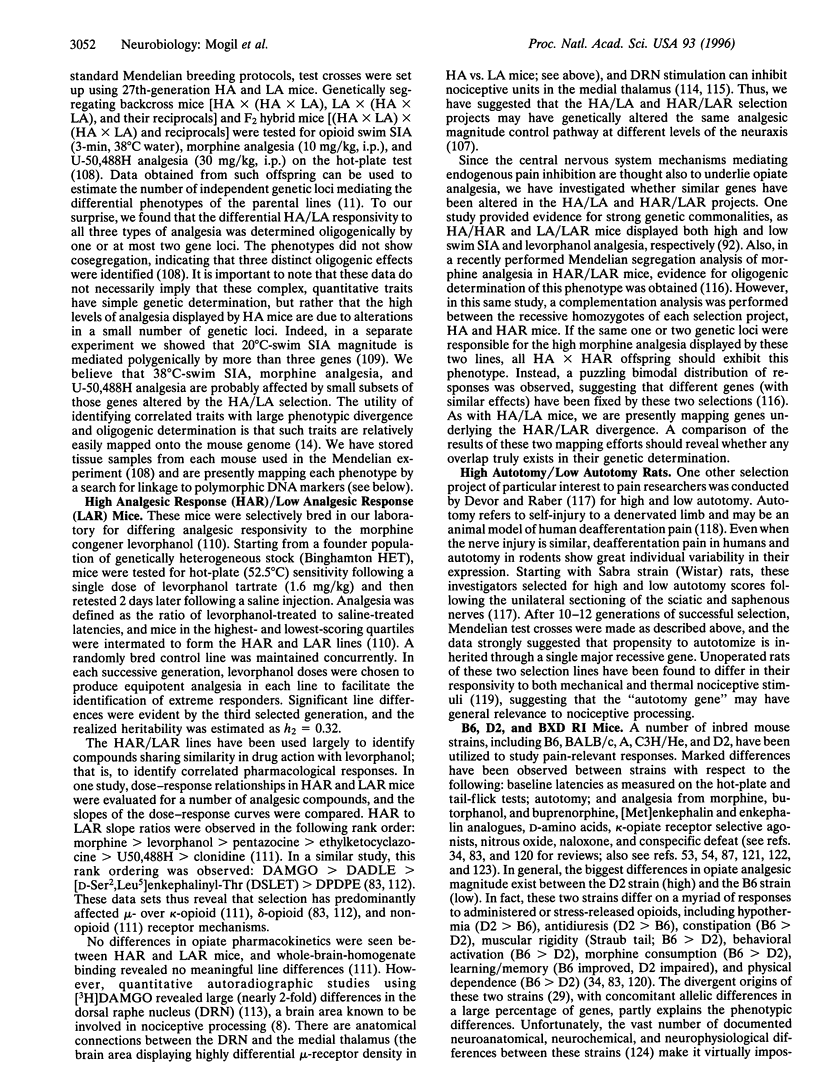
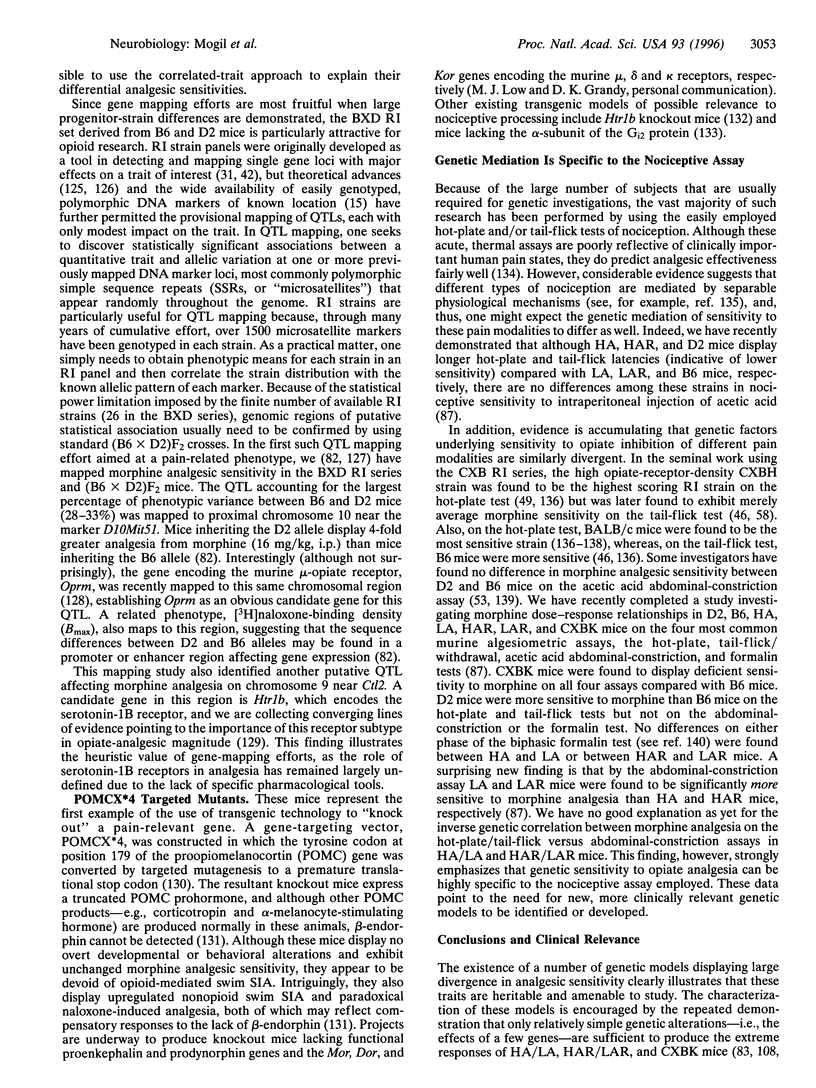
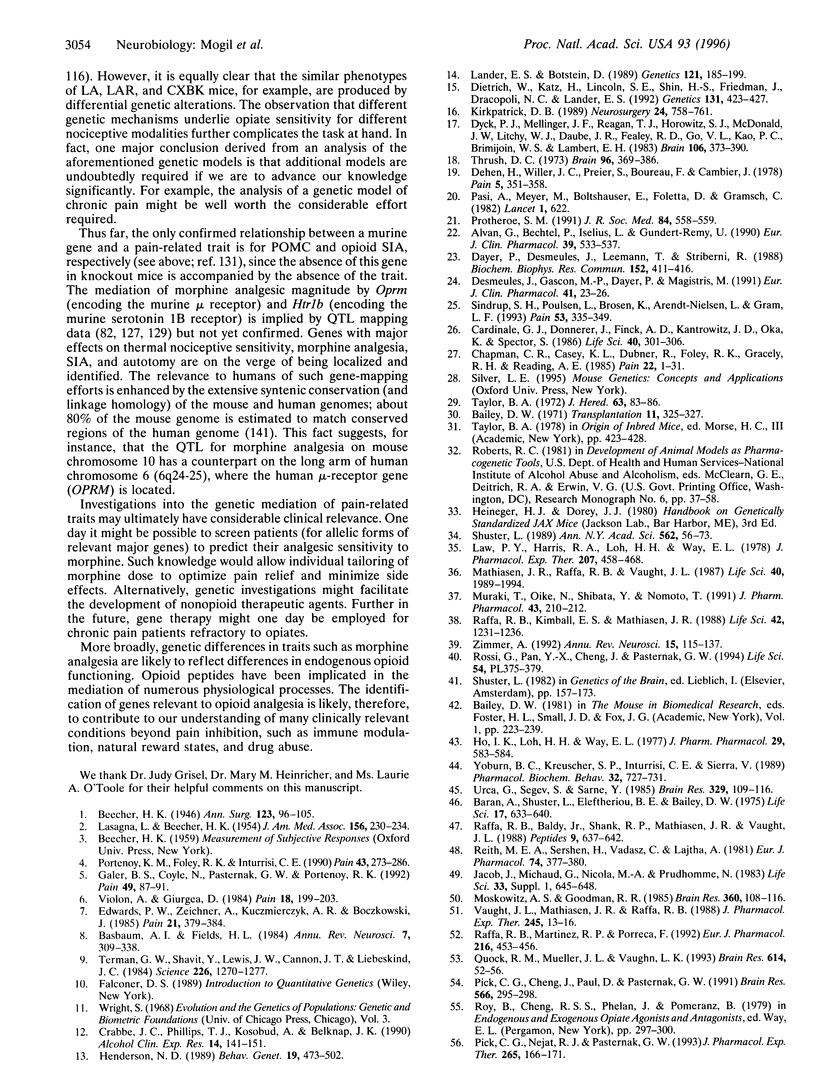
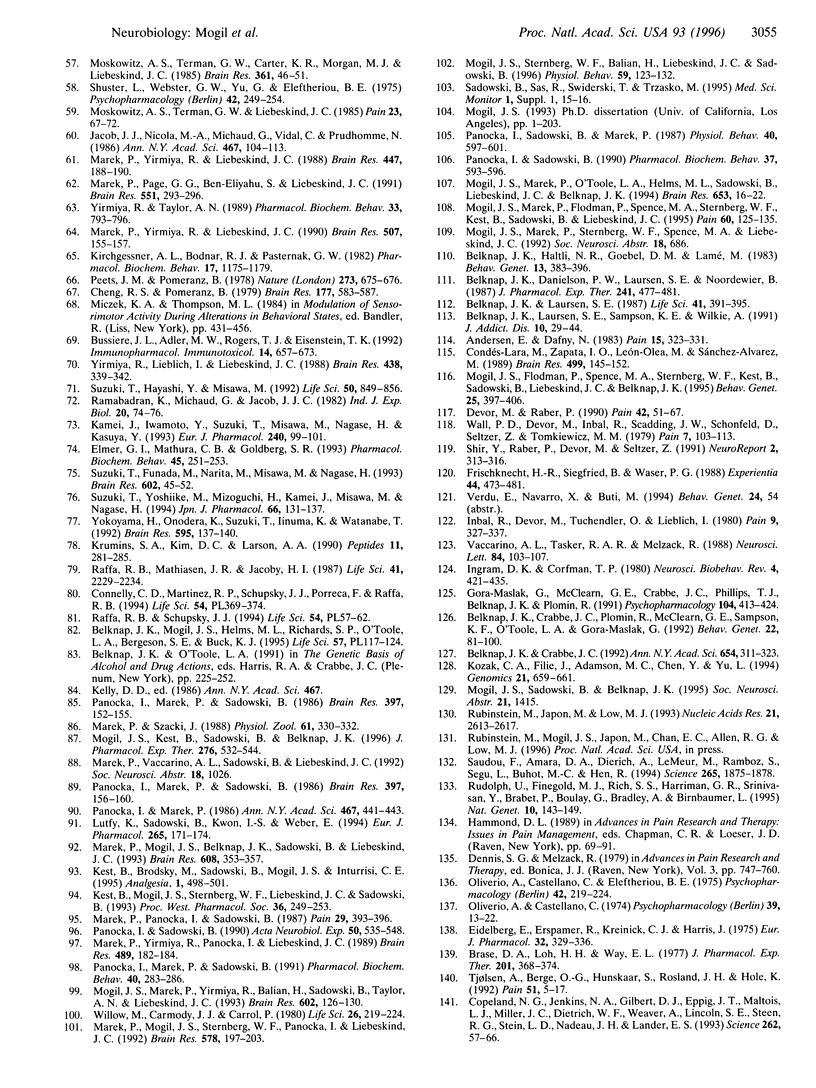
Selected References
These references are in PubMed. This may not be the complete list of references from this article.
- Alván G., Bechtel P., Iselius L., Gundert-Remy U. Hydroxylation polymorphisms of debrisoquine and mephenytoin in European populations. Eur J Clin Pharmacol. 1990;39(6):533–537. doi: 10.1007/BF00316090. [DOI] [PubMed] [Google Scholar]
- Andersen E., Dafny N. Dorsal raphe stimulation reduces responses of parafascicular neurons to noxious stimulation. Pain. 1983 Apr;15(4):323–331. doi: 10.1016/0304-3959(83)90069-6. [DOI] [PubMed] [Google Scholar]
- Bailey D. W. Recombinant-inbred strains. An aid to finding identity, linkage, and function of histocompatibility and other genes. Transplantation. 1971 Mar;11(3):325–327. doi: 10.1097/00007890-197103000-00013. [DOI] [PubMed] [Google Scholar]
- Baran A., Shuster L., Eleftheriou B. E., Bailey D. W. Opiate receptors in mice: genetic differences. Life Sci. 1975 Aug 15;17(4):633–640. doi: 10.1016/0024-3205(75)90101-0. [DOI] [PubMed] [Google Scholar]
- Basbaum A. I., Fields H. L. Endogenous pain control systems: brainstem spinal pathways and endorphin circuitry. Annu Rev Neurosci. 1984;7:309–338. doi: 10.1146/annurev.ne.07.030184.001521. [DOI] [PubMed] [Google Scholar]
- Beecher H. K. Pain in Men Wounded in Battle. Ann Surg. 1946 Jan;123(1):96–105. [PMC free article] [PubMed] [Google Scholar]
- Belknap J. K., Crabbe J. C. Chromosome mapping of gene loci affecting morphine and amphetamine responses in BXD recombinant inbred mice. Ann N Y Acad Sci. 1992 Jun 28;654:311–323. doi: 10.1111/j.1749-6632.1992.tb25977.x. [DOI] [PubMed] [Google Scholar]
- Belknap J. K., Crabbe J. C., Plomin R., McClearn G. E., Sampson K. E., O'Toole L. A., Gora-Maslak G. Single-locus control of saccharin intake in BXD/Ty recombinant inbred (RI) mice: some methodological implications for RI strain analysis. Behav Genet. 1992 Jan;22(1):81–100. doi: 10.1007/BF01066794. [DOI] [PubMed] [Google Scholar]
- Belknap J. K., Danielson P. W., Laursen S. E., Noordewier B. Selective breeding for levorphanol-induced antinociception on the hot-plate assay: commonalities in mechanism of action with morphine, pentazocine, ethylketocyclazocine, U-50488H and clonidine in mice. J Pharmacol Exp Ther. 1987 May;241(2):477–481. [PubMed] [Google Scholar]
- Belknap J. K., Haltli N. R., Goebel D. M., Lamé M. Selective breeding for high and low levels of opiate-induced analgesia in mice. Behav Genet. 1983 Jul;13(4):383–396. doi: 10.1007/BF01065776. [DOI] [PubMed] [Google Scholar]
- Belknap J. K., Laursen S. E. DSLET (D-ser2-leu5-enkephalin-Thr6) produces analgesia on the hot plate by mechanisms largely different from DAGO and morphine-like opioids. Life Sci. 1987 Jul 27;41(4):391–395. doi: 10.1016/0024-3205(87)90213-x. [DOI] [PubMed] [Google Scholar]
- Belknap J. K., Laursen S. E., Sampson K. E., Wilkie A. Where are the mu receptors that mediate opioid analgesia? An autoradiographic study in the HAR and LAR selection lines. J Addict Dis. 1991;10(1-2):29–44. doi: 10.1300/J069v10n01_03. [DOI] [PubMed] [Google Scholar]
- Belknap J. K., Mogil J. S., Helms M. L., Richards S. P., O'Toole L. A., Bergeson S. E., Buck K. J. Localization to chromosome 10 of a locus influencing morphine analgesia in crosses derived from C57BL/6 and DBA/2 strains. Life Sci. 1995;57(10):PL117–PL124. doi: 10.1016/0024-3205(95)02040-p. [DOI] [PubMed] [Google Scholar]
- Brase D. A., Loh H. H., Way E. L. Comparison of the effects of morphine on locomotor activity, analgesia and primary and protracted physical dependence in six mouse strains. J Pharmacol Exp Ther. 1977 May;201(2):368–374. [PubMed] [Google Scholar]
- Bussiere J. L., Adler M. W., Rogers T. J., Eisenstein T. K. Differential effects of morphine and naltrexone on the antibody response in various mouse strains. Immunopharmacol Immunotoxicol. 1992;14(3):657–673. doi: 10.3109/08923979209005416. [DOI] [PubMed] [Google Scholar]
- Cardinale G. J., Donnerer J., Finck A. D., Kantrowitz J. D., Oka K., Spector S. Morphine and codeine are endogenous components of human cerebrospinal fluid. Life Sci. 1987 Jan 19;40(3):301–306. doi: 10.1016/0024-3205(87)90347-x. [DOI] [PubMed] [Google Scholar]
- Chapman C. R., Casey K. L., Dubner R., Foley K. M., Gracely R. H., Reading A. E. Pain measurement: an overview. Pain. 1985 May;22(1):1–31. doi: 10.1016/0304-3959(85)90145-9. [DOI] [PubMed] [Google Scholar]
- Cheng R. S., Pomeranz B. Correlation of genetic differences in endorphin systems with analgesic effects of D-amino acids in mice. Brain Res. 1979 Nov 30;177(3):583–587. doi: 10.1016/0006-8993(79)90477-3. [DOI] [PubMed] [Google Scholar]
- Condés-Lara M., Omaña Zapata I., León-Olea M., Sánchez-Alvarez M. Dorsal raphe and nociceptive stimulations evoke convergent responses on the thalamic centralis lateralis and medial prefrontal cortex neurons. Brain Res. 1989 Oct 9;499(1):145–152. doi: 10.1016/0006-8993(89)91144-x. [DOI] [PubMed] [Google Scholar]
- Connelly C. D., Martinez R. P., Schupsky J. J., Porreca F., Raffa R. B. Etonitazene-induced antinociception in mu1 opioid receptor deficient CXBK mice: evidence for a role for mu2 receptors in supraspinal antinociception. Life Sci. 1994;54(21):PL369–PL374. doi: 10.1016/0024-3205(94)90037-x. [DOI] [PubMed] [Google Scholar]
- Copeland N. G., Jenkins N. A., Gilbert D. J., Eppig J. T., Maltais L. J., Miller J. C., Dietrich W. F., Weaver A., Lincoln S. E., Steen R. G. A genetic linkage map of the mouse: current applications and future prospects. Science. 1993 Oct 1;262(5130):57–66. doi: 10.1126/science.8211130. [DOI] [PubMed] [Google Scholar]
- Crabbe J. C., Phillips T. J., Kosobud A., Belknap J. K. Estimation of genetic correlation: interpretation of experiments using selectively bred and inbred animals. Alcohol Clin Exp Res. 1990 Apr;14(2):141–151. doi: 10.1111/j.1530-0277.1990.tb00461.x. [DOI] [PubMed] [Google Scholar]
- Dayer P., Desmeules J., Leemann T., Striberni R. Bioactivation of the narcotic drug codeine in human liver is mediated by the polymorphic monooxygenase catalyzing debrisoquine 4-hydroxylation (cytochrome P-450 dbl/bufI). Biochem Biophys Res Commun. 1988 Apr 15;152(1):411–416. doi: 10.1016/s0006-291x(88)80729-0. [DOI] [PubMed] [Google Scholar]
- Dehen H., Willer J. C., Prier S., Boureau F., Cambier J. Congenital insensitivity to pain and the "morphine-like" analgesic system. Pain. 1978 Dec;5(4):351–358. doi: 10.1016/0304-3959(78)90003-9. [DOI] [PubMed] [Google Scholar]
- Desmeules J., Gascon M. P., Dayer P., Magistris M. Impact of environmental and genetic factors on codeine analgesia. Eur J Clin Pharmacol. 1991;41(1):23–26. doi: 10.1007/BF00280101. [DOI] [PubMed] [Google Scholar]
- Devor M., Raber P. Heritability of symptoms in an experimental model of neuropathic pain. Pain. 1990 Jul;42(1):51–67. doi: 10.1016/0304-3959(90)91092-W. [DOI] [PubMed] [Google Scholar]
- Dietrich W., Katz H., Lincoln S. E., Shin H. S., Friedman J., Dracopoli N. C., Lander E. S. A genetic map of the mouse suitable for typing intraspecific crosses. Genetics. 1992 Jun;131(2):423–447. doi: 10.1093/genetics/131.2.423. [DOI] [PMC free article] [PubMed] [Google Scholar]
- Dyck P. J., Mellinger J. F., Reagan T. J., Horowitz S. J., McDonald J. W., Litchy W. J., Daube J. R., Fealey R. D., Go V. L., Kao P. C. Not 'indifference to pain' but varieties of hereditary sensory and autonomic neuropathy. Brain. 1983 Jun;106(Pt 2):373–390. doi: 10.1093/brain/106.2.373. [DOI] [PubMed] [Google Scholar]
- Edwards P. W., Zeichner A., Kuczmierczyk A. R., Boczkowski J. Familial pain models: the relationship between family history of pain and current pain experience. Pain. 1985 Apr;21(4):379–384. doi: 10.1016/0304-3959(85)90166-6. [DOI] [PubMed] [Google Scholar]
- Eidelberg E., Erspamer R., Kreinick C. J., Harris J. Genetically determined differences in the effects of morphine on mice. Eur J Pharmacol. 1975 Jun-Jul;32(02):329–336. doi: 10.1016/0014-2999(75)90300-3. [DOI] [PubMed] [Google Scholar]
- Elmer G. I., Mathura C. B., Goldberg S. R. Genetic factors in conditioned tolerance to the analgesic effects of etonitazene. Pharmacol Biochem Behav. 1993 May;45(1):251–253. doi: 10.1016/0091-3057(93)90115-a. [DOI] [PubMed] [Google Scholar]
- Frischknecht H. R., Siegfried B., Waser P. G. Opioids and behavior: genetic aspects. Experientia. 1988 Jun 15;44(6):473–481. doi: 10.1007/BF01958921. [DOI] [PubMed] [Google Scholar]
- Galer B. S., Coyle N., Pasternak G. W., Portenoy R. K. Individual variability in the response to different opioids: report of five cases. Pain. 1992 Apr;49(1):87–91. doi: 10.1016/0304-3959(92)90192-E. [DOI] [PubMed] [Google Scholar]
- Gora-Maslak G., McClearn G. E., Crabbe J. C., Phillips T. J., Belknap J. K., Plomin R. Use of recombinant inbred strains to identify quantitative trait loci in psychopharmacology. Psychopharmacology (Berl) 1991;104(4):413–424. doi: 10.1007/BF02245643. [DOI] [PubMed] [Google Scholar]
- Henderson N. D. Interpreting studies that compare high- and low-selected lines on new characters. Behav Genet. 1989 Jul;19(4):473–502. doi: 10.1007/BF01066250. [DOI] [PubMed] [Google Scholar]
- Ho I. K., Loh H. H., Way E. L. Morphine analgesia, tolerance and dependence in mice from different strains and vendors. J Pharm Pharmacol. 1977 Sep;29(9):583–584. doi: 10.1111/j.2042-7158.1977.tb11409.x. [DOI] [PubMed] [Google Scholar]
- Inbal R., Devor M., Tuchendler O., Lieblich I. Autotomy following nerve injury: genetic factors in the development of chronic pain. Pain. 1980 Dec;9(3):327–337. doi: 10.1016/0304-3959(80)90047-0. [DOI] [PubMed] [Google Scholar]
- Ingram D. K., Corfman T. P. An overview of neurobiological comparisons in mouse strains. Neurosci Biobehav Rev. 1980 Winter;4(4):421–435. doi: 10.1016/0149-7634(80)90032-9. [DOI] [PubMed] [Google Scholar]
- Jacob J. J., Nicola M. A., Michaud G., Vidal C., Prudhomme N. Genetic modulations of stress-induced analgesia in mice. Ann N Y Acad Sci. 1986;467:104–115. doi: 10.1111/j.1749-6632.1986.tb14622.x. [DOI] [PubMed] [Google Scholar]
- Jacob J., Michaud G., Nicola M. A., Prudhomme N. Genetic differences in opioids binding sites and in antinociceptive activities of morphine and ethylketocyclazocine. Life Sci. 1983;33 (Suppl 1):645–648. doi: 10.1016/0024-3205(83)90585-4. [DOI] [PubMed] [Google Scholar]
- Kest B., Mogil J. S., Sternberg W. F., Liebeskind J. C., Sadowski B. Evidence for the up-regulation of kappa opiate mechanisms in mice selectively bred for high analgesia. Proc West Pharmacol Soc. 1993;36:249–253. [PubMed] [Google Scholar]
- Kirchgessner A. L., Bodnar R. J., Pasternak G. W. Naloxazone and pain-inhibitory systems: evidence for a collateral inhibition model. Pharmacol Biochem Behav. 1982 Dec;17(6):1175–1179. doi: 10.1016/0091-3057(82)90116-2. [DOI] [PubMed] [Google Scholar]
- Kirkpatrick D. B. Familial trigeminal neuralgia: case report. Neurosurgery. 1989 May;24(5):758–761. doi: 10.1227/00006123-198905000-00018. [DOI] [PubMed] [Google Scholar]
- Kozak C. A., Filie J., Adamson M. C., Chen Y., Yu L. Murine chromosomal location of the mu and kappa opioid receptor genes. Genomics. 1994 Jun;21(3):659–661. doi: 10.1006/geno.1994.1331. [DOI] [PubMed] [Google Scholar]
- Krumins S. A., Kim D. C., Larson A. A. Substance P modulation of DAMGO binding in the brain of CXBK and Swiss-Webster mice. Peptides. 1990 Mar-Apr;11(2):281–285. doi: 10.1016/0196-9781(90)90083-h. [DOI] [PubMed] [Google Scholar]
- LASAGNA L., BEECHER H. K. The optimal dose of morphine. J Am Med Assoc. 1954 Sep 18;156(3):230–234. doi: 10.1001/jama.1954.02950030022008. [DOI] [PubMed] [Google Scholar]
- Lander E. S., Botstein D. Mapping mendelian factors underlying quantitative traits using RFLP linkage maps. Genetics. 1989 Jan;121(1):185–199. doi: 10.1093/genetics/121.1.185. [DOI] [PMC free article] [PubMed] [Google Scholar]
- Law P. Y., Harris R. A., Loh H. H., Way E. L. Evidence for the involvement of cerebroside sulfate in opiate receptor binding: Studies with Azure A and jimpy mutant mice. J Pharmacol Exp Ther. 1978 Nov;207(2):458–468. [PubMed] [Google Scholar]
- Lutfy K., Sadowski B., Kwon I. S., Weber E. Morphine analgesia and tolerance in mice selectively bred for divergent swim stress-induced analgesia. Eur J Pharmacol. 1994 Nov 24;265(3):171–174. doi: 10.1016/0014-2999(94)90428-6. [DOI] [PubMed] [Google Scholar]
- Marek P., Mogil J. S., Belknap J. K., Sadowski B., Liebeskind J. C. Levorphanol and swim stress-induced analgesia in selectively bred mice: evidence for genetic commonalities. Brain Res. 1993 Apr 16;608(2):353–357. doi: 10.1016/0006-8993(93)91479-c. [DOI] [PubMed] [Google Scholar]
- Marek P., Mogil J. S., Sternberg W. F., Panocka I., Liebeskind J. C. N-methyl-D-aspartic acid (NMDA) receptor antagonist MK-801 blocks non-opioid stress-induced analgesia. II. Comparison across three swim-stress paradigms in selectively bred mice. Brain Res. 1992 Apr 24;578(1-2):197–203. doi: 10.1016/0006-8993(92)90248-8. [DOI] [PubMed] [Google Scholar]
- Marek P., Page G. G., Ben-Eliyahu S., Liebeskind J. C. N-methyl-D-aspartic acid (NMDA) receptor antagonist MK-801 blocks non-opioid stress-induced analgesia. I. Comparison of opiate receptor-deficient and opiate receptor-rich strains of mice. Brain Res. 1991 Jun 14;551(1-2):293–296. doi: 10.1016/0006-8993(91)90943-p. [DOI] [PubMed] [Google Scholar]
- Marek P., Panocka I., Sadowski B. Selective breeding of mice for high and low swim analgesia: differential effect on discrete forms of footshock analgesia. Pain. 1987 Jun;29(3):393–398. doi: 10.1016/0304-3959(87)90054-6. [DOI] [PubMed] [Google Scholar]
- Marek P., Yirmiya R., Liebeskind J. C. Genetic influences on brain stimulation-produced analgesia in mice: II. Correlation with brain opiate receptor concentration. Brain Res. 1990 Jan 15;507(1):155–157. doi: 10.1016/0006-8993(90)90536-k. [DOI] [PubMed] [Google Scholar]
- Marek P., Yirmiya R., Liebeskind J. C. Strain differences in the magnitude of swimming-induced analgesia in mice correlate with brain opiate receptor concentration. Brain Res. 1988 Apr 26;447(1):188–190. doi: 10.1016/0006-8993(88)90984-5. [DOI] [PubMed] [Google Scholar]
- Marek P., Yirmiya R., Panocka I., Liebeskind J. C. Genetic influences on brain stimulation-produced analgesia in mice. I. Correlation with stress-induced analgesia. Brain Res. 1989 Jun 5;489(1):182–184. doi: 10.1016/0006-8993(89)90022-x. [DOI] [PubMed] [Google Scholar]
- Mathiasen J. R., Raffa R. B., Vaught J. L. C57BL/6J-bgJ (beige) mice: differential sensitivity in the tail flick test to centrally administered mu- and delta-opioid receptor agonists. Life Sci. 1987 May 18;40(20):1989–1994. doi: 10.1016/0024-3205(87)90288-8. [DOI] [PubMed] [Google Scholar]
- Mogil J. S., Flodman P., Spence M. A., Sternberg W. F., Kest B., Sadowski B., Liebeskind J. C., Belknap J. K. Oligogenic determination of morphine analgesic magnitude: a genetic analysis of selectively bred mouse lines. Behav Genet. 1995 Jul;25(4):397–406. doi: 10.1007/BF02197290. [DOI] [PubMed] [Google Scholar]
- Mogil J. S., Kest B., Sadowski B., Belknap J. K. Differential genetic mediation of sensitivity to morphine in genetic models of opiate antinociception: influence of nociceptive assay. J Pharmacol Exp Ther. 1996 Feb;276(2):532–544. [PubMed] [Google Scholar]
- Mogil J. S., Marek P., Flodman P., Spence M. A., Sternberg W. F., Kest B., Sadowski B., Liebeskind J. C. One or two genetic loci mediate high opiate analgesia in selectively bred mice. Pain. 1995 Feb;60(2):125–135. doi: 10.1016/0304-3959(94)00098-Y. [DOI] [PubMed] [Google Scholar]
- Mogil J. S., Marek P., O'Toole L. A., Helms M. L., Sadowski B., Liebeskind J. C., Belknap J. K. Mu-opiate receptor binding is up-regulated in mice selectively bred for high stress-induced analgesia. Brain Res. 1994 Aug 8;653(1-2):16–22. doi: 10.1016/0006-8993(94)90366-2. [DOI] [PubMed] [Google Scholar]
- Mogil J. S., Marek P., Yirmiya R., Balian H., Sadowski B., Taylor A. N., Liebeskind J. C. Antagonism of the non-opioid component of ethanol-induced analgesia by the NMDA receptor antagonist MK-801. Brain Res. 1993 Jan 29;602(1):126–130. doi: 10.1016/0006-8993(93)90251-h. [DOI] [PubMed] [Google Scholar]
- Mogil J. S., Sternberg W. F., Balian H., Liebeskind J. C., Sadowski B. Opioid and nonopioid swim stress-induced analgesia: a parametric analysis in mice. Physiol Behav. 1996 Jan;59(1):123–132. doi: 10.1016/0031-9384(95)02073-x. [DOI] [PubMed] [Google Scholar]
- Moskowitz A. S., Goodman R. R. Autoradiographic analysis of mu1, mu2, and delta opioid binding in the central nervous system of C57BL/6BY and CXBK (opioid receptor-deficient) mice. Brain Res. 1985 Dec 23;360(1-2):108–116. doi: 10.1016/0006-8993(85)91226-0. [DOI] [PubMed] [Google Scholar]
- Moskowitz A. S., Terman G. W., Liebeskind J. C. Stress-induced analgesia in the mouse: strain comparisons. Pain. 1985 Sep;23(1):67–72. doi: 10.1016/0304-3959(85)90231-3. [DOI] [PubMed] [Google Scholar]
- Muraki T., Oike N., Shibata Y., Nomoto T. Analgesic effect of mu- and kappa-opioid agonists in beige and CXBK mice. J Pharm Pharmacol. 1991 Mar;43(3):210–212. doi: 10.1111/j.2042-7158.1991.tb06669.x. [DOI] [PubMed] [Google Scholar]
- Oliverio A., Castellano C., Eleftheriou B. E. Morphine sensitivity and tolerance: a genetic investigation in the mouse. Psychopharmacologia. 1975 Jun 19;42(3):219–224. doi: 10.1007/BF00421259. [DOI] [PubMed] [Google Scholar]
- Oliverio A., Castellano C. Genotype-dependent sensitivity and tolerance to morphine and heroin: dissociation between opiate-induced running and analgesia in the mouse. Psychopharmacologia. 1974;39(1):13–22. doi: 10.1007/BF00421454. [DOI] [PubMed] [Google Scholar]
- Panocka I., Marek P., Sadowski B. Differentiation of neurochemical basis of stress-induced analgesia in mice by selective breeding. Brain Res. 1986 Nov 5;397(1):156–160. doi: 10.1016/0006-8993(86)91380-6. [DOI] [PubMed] [Google Scholar]
- Panocka I., Marek P., Sadowski B. Inheritance of stress-induced analgesia in mice. Selective breeding study. Brain Res. 1986 Nov 5;397(1):152–155. doi: 10.1016/0006-8993(86)91379-x. [DOI] [PubMed] [Google Scholar]
- Panocka I., Marek P., Sadowski B. Tolerance and cross-tolerance with morphine in mice selectively bred for high and low stress-induced analgesia. Pharmacol Biochem Behav. 1991 Oct;40(2):283–286. doi: 10.1016/0091-3057(91)90553-e. [DOI] [PubMed] [Google Scholar]
- Panocka I., Sadowski B. Correlation between magnitude and opioid mediation of stress-induced analgesia: individual differences and the effect of selective breeding. Acta Neurobiol Exp (Wars) 1990;50(6):535–538. [PubMed] [Google Scholar]
- Panocka I., Sadowski B., Marek P. Adrenalectomy and dexamethasone differentially affect postswim antinociception in mice selectively bred for high and low stress-induced analgesia. Physiol Behav. 1987;40(5):597–601. doi: 10.1016/0031-9384(87)90103-x. [DOI] [PubMed] [Google Scholar]
- Panocka I., Sadowski B. Potentiation of swim analgesia by D-amino acids in mice is genotype dependent. Pharmacol Biochem Behav. 1990 Dec;37(4):593–596. doi: 10.1016/0091-3057(90)90532-m. [DOI] [PubMed] [Google Scholar]
- Pasi A., Meyer M., Boltshauser E., Foletta D., Gramsch C. Failure of naloxone to reverse analgesia in congenital insensitivity to pain, and variable plasma levels of beta-endorphin-like activity. Lancet. 1982 Mar 13;1(8272):622–622. doi: 10.1016/s0140-6736(82)91776-7. [DOI] [PubMed] [Google Scholar]
- Pick C. G., Cheng J., Paul D., Pasternak G. W. Genetic influences in opioid analgesic sensitivity in mice. Brain Res. 1991 Dec 6;566(1-2):295–298. doi: 10.1016/0006-8993(91)91712-a. [DOI] [PubMed] [Google Scholar]
- Pick C. G., Nejat R. J., Pasternak G. W. Independent expression of two pharmacologically distinct supraspinal mu analgesic systems in genetically different mouse strains. J Pharmacol Exp Ther. 1993 Apr;265(1):166–171. [PubMed] [Google Scholar]
- Portenoy R. K., Foley K. M., Inturrisi C. E. The nature of opioid responsiveness and its implications for neuropathic pain: new hypotheses derived from studies of opioid infusions. Pain. 1990 Dec;43(3):273–286. doi: 10.1016/0304-3959(90)90025-9. [DOI] [PubMed] [Google Scholar]
- Protheroe S. M. Congenital insensitivity to pain. J R Soc Med. 1991 Sep;84(9):558–559. doi: 10.1177/014107689108400918. [DOI] [PMC free article] [PubMed] [Google Scholar]
- Quock R. M., Mueller J. L., Vaughn L. K. Strain-dependent differences in responsiveness of mice to nitrous oxide (N2O) antinociception. Brain Res. 1993 Jun 18;614(1-2):52–56. doi: 10.1016/0006-8993(93)91017-m. [DOI] [PubMed] [Google Scholar]
- Raffa R. B., Baldy W. J., Jr, Shank R. P., Mathiasen J. R., Vaught J. L. [3H][D-Ala2,NMePhe4,Gly-ol5]-enkephalin (mu-opioid) binding in beige-J mice. Peptides. 1988 May-Jun;9(3):637–642. doi: 10.1016/0196-9781(88)90176-3. [DOI] [PubMed] [Google Scholar]
- Raffa R. B., Kimball E. S., Mathiasen J. R. The analgesic defect of C57BL/6J-bgJ/bgJ (beige-J: Chediak-Higashi syndrome) mice transmitted by adoptive transfer of spleen cells to normal littermates. Life Sci. 1988;42(12):1231–1236. doi: 10.1016/0024-3205(88)90554-1. [DOI] [PubMed] [Google Scholar]
- Raffa R. B., Martinez R. P., Porreca F. Lack of antinociceptive efficacy of intracerebroventricular [D-Ala2,Glu4]deltorphin, but not [D-Pen2,D-Pen5]enkephalin, in the mu-opioid receptor deficient CXBK mouse. Eur J Pharmacol. 1992 Jun 17;216(3):453–456. doi: 10.1016/0014-2999(92)90446-b. [DOI] [PubMed] [Google Scholar]
- Raffa R. B., Mathiasen J. R., Jacoby H. I. Colonic bead expulsion time in normal and mu-opioid receptor deficient (CXBK) mice following central (ICV) administration of mu- and delta-opioid agonists. Life Sci. 1987 Nov 9;41(19):2229–2234. doi: 10.1016/0024-3205(87)90520-0. [DOI] [PubMed] [Google Scholar]
- Ramabadran K., Michaud G., Jacob J. J. Genetic influences on the control of nociceptive responses & precipitated abstinence in mice. Indian J Exp Biol. 1982 Jan;20(1):74–76. [PubMed] [Google Scholar]
- Reith M. E., Sershen H., Vadasz C., Lajtha A. Strain differences in opiate receptors in mouse brain. Eur J Pharmacol. 1981 Sep 24;74(4):377–380. doi: 10.1016/0014-2999(81)90059-5. [DOI] [PubMed] [Google Scholar]
- Rossi G., Pan Y. X., Cheng J., Pasternak G. W. Blockade of morphine analgesia by an antisense oligodeoxynucleotide against the mu receptor. Life Sci. 1994;54(21):PL375–PL379. doi: 10.1016/0024-3205(94)90038-8. [DOI] [PubMed] [Google Scholar]
- Rubinstein M., Japón M. A., Low M. J. Introduction of a point mutation into the mouse genome by homologous recombination in embryonic stem cells using a replacement type vector with a selectable marker. Nucleic Acids Res. 1993 Jun 11;21(11):2613–2617. doi: 10.1093/nar/21.11.2613. [DOI] [PMC free article] [PubMed] [Google Scholar]
- Rudolph U., Finegold M. J., Rich S. S., Harriman G. R., Srinivasan Y., Brabet P., Boulay G., Bradley A., Birnbaumer L. Ulcerative colitis and adenocarcinoma of the colon in G alpha i2-deficient mice. Nat Genet. 1995 Jun;10(2):143–150. doi: 10.1038/ng0695-143. [DOI] [PubMed] [Google Scholar]
- Saudou F., Amara D. A., Dierich A., LeMeur M., Ramboz S., Segu L., Buhot M. C., Hen R. Enhanced aggressive behavior in mice lacking 5-HT1B receptor. Science. 1994 Sep 23;265(5180):1875–1878. doi: 10.1126/science.8091214. [DOI] [PubMed] [Google Scholar]
- Shir Y., Raber P., Devor M., Seltzer Z. Mechano- and thermo-sensitivity in rats genetically prone to developing neuropathic pain. Neuroreport. 1991 Jun;2(6):313–316. doi: 10.1097/00001756-199106000-00003. [DOI] [PubMed] [Google Scholar]
- Shuster L. Pharmacogenetics of drugs of abuse. Ann N Y Acad Sci. 1989;562:56–73. doi: 10.1111/j.1749-6632.1989.tb21007.x. [DOI] [PubMed] [Google Scholar]
- Shuster L., Webster G. W., Yu G., Eleftheriou B. E. A genetic analysis of the response to morphine in mice: analgesia and running. Psychopharmacologia. 1975 Jun 19;42(3):249–254. doi: 10.1007/BF00421264. [DOI] [PubMed] [Google Scholar]
- Sindrup S. H., Poulsen L., Brøsen K., Arendt-Nielsen L., Gram L. F. Are poor metabolisers of sparteine/debrisoquine less pain tolerant than extensive metabolisers? Pain. 1993 Jun;53(3):335–339. doi: 10.1016/0304-3959(93)90229-I. [DOI] [PubMed] [Google Scholar]
- Suzuki T., Funada M., Narita M., Misawa M., Nagase H. Morphine-induced place preference in the CXBK mouse: characteristics of mu opioid receptor subtypes. Brain Res. 1993 Jan 29;602(1):45–52. doi: 10.1016/0006-8993(93)90239-j. [DOI] [PubMed] [Google Scholar]
- Suzuki T., Hayashi Y., Misawa M. The role of mu1 receptor in physical dependence on morphine using the mu receptor deficient CXBK mouse. Life Sci. 1992;50(12):849–856. doi: 10.1016/0024-3205(92)90203-2. [DOI] [PubMed] [Google Scholar]
- Suzuki T., Yoshiike M., Mizoguchi H., Kamei J., Misawa M., Nagase H. Blockade of delta-opioid receptors prevents morphine-induced place preference in mice. Jpn J Pharmacol. 1994 Sep;66(1):131–137. doi: 10.1254/jjp.66.131. [DOI] [PubMed] [Google Scholar]
- Taylor B. A. Genetic relationships between inbred strains of mice. J Hered. 1972 Mar-Apr;63(2):83–86. doi: 10.1093/oxfordjournals.jhered.a108235. [DOI] [PubMed] [Google Scholar]
- Terman G. W., Shavit Y., Lewis J. W., Cannon J. T., Liebeskind J. C. Intrinsic mechanisms of pain inhibition: activation by stress. Science. 1984 Dec 14;226(4680):1270–1277. doi: 10.1126/science.6505691. [DOI] [PubMed] [Google Scholar]
- Thrush D. C. Congenital insensitivity to pain. A clinical, genetic and neurophysiological study of four children from the same family. Brain. 1973 Jun;96(2):369–386. doi: 10.1093/brain/96.2.369. [DOI] [PubMed] [Google Scholar]
- Tjølsen A., Berge O. G., Hunskaar S., Rosland J. H., Hole K. The formalin test: an evaluation of the method. Pain. 1992 Oct;51(1):5–17. doi: 10.1016/0304-3959(92)90003-T. [DOI] [PubMed] [Google Scholar]
- Urca G., Segev S., Sarne Y. Footshock-induced analgesia: its opioid nature depends on the strain of rat. Brain Res. 1985 Mar 11;329(1-2):109–116. doi: 10.1016/0006-8993(85)90516-5. [DOI] [PubMed] [Google Scholar]
- Vaccarino A. L., Tasker R. A., Melzack R. Systemic administration of naloxone produces analgesia in BALB/c mice in the formalin pain test. Neurosci Lett. 1988 Jan 11;84(1):103–107. doi: 10.1016/0304-3940(88)90345-x. [DOI] [PubMed] [Google Scholar]
- Vaught J. L., Mathiasen J. R., Raffa R. B. Examination of the involvement of supraspinal and spinal mu and delta opioid receptors in analgesia using the mu receptor deficient CXBK mouse. J Pharmacol Exp Ther. 1988 Apr;245(1):13–16. [PubMed] [Google Scholar]
- Violon A., Giurgea D. Familial models for chronic pain. Pain. 1984 Feb;18(2):199–203. doi: 10.1016/0304-3959(84)90887-X. [DOI] [PubMed] [Google Scholar]
- Wall P. D., Devor M., Inbal R., Scadding J. W., Schonfeld D., Seltzer Z., Tomkiewicz M. M. Autotomy following peripheral nerve lesions: experimental anaesthesia dolorosa. Pain. 1979 Oct;7(2):103–111. doi: 10.1016/0304-3959(79)90002-2. [DOI] [PubMed] [Google Scholar]
- Willow M., Carmody J., Carroll P. The effects of swimming in mice on pain perception and sleeping time in response to hypnotic drugs. Life Sci. 1980 Jan 21;26(3):219–224. doi: 10.1016/0024-3205(80)90296-9. [DOI] [PubMed] [Google Scholar]
- Yirmiya R., Lieblich I., Liebeskind J. C. Reduced saccharin preference in CXBK (opioid receptor-deficient) mice. Brain Res. 1988 Jan 12;438(1-2):339–342. doi: 10.1016/0006-8993(88)91360-1. [DOI] [PubMed] [Google Scholar]
- Yirmiya R., Taylor A. N. Genetic differences in opiate receptor concentration and sensitivity to ethanol's effects. Pharmacol Biochem Behav. 1989 Aug;33(4):793–796. doi: 10.1016/0091-3057(89)90472-3. [DOI] [PubMed] [Google Scholar]
- Yoburn B. C., Kreuscher S. P., Inturrisi C. E., Sierra V. Opioid receptor upregulation and supersensitivity in mice: effect of morphine sensitivity. Pharmacol Biochem Behav. 1989 Mar;32(3):727–731. doi: 10.1016/0091-3057(89)90025-7. [DOI] [PubMed] [Google Scholar]
- Yokoyama H., Onodera K., Suzuki T., Iinuma K., Watanabe T. Opioid mu-deficient CXBK mouse and the role of mu 1-receptors in electrically induced convulsions. Brain Res. 1992 Nov 6;595(1):137–140. doi: 10.1016/0006-8993(92)91463-o. [DOI] [PubMed] [Google Scholar]
- Zimmer A. Manipulating the genome by homologous recombination in embryonic stem cells. Annu Rev Neurosci. 1992;15:115–137. doi: 10.1146/annurev.ne.15.030192.000555. [DOI] [PubMed] [Google Scholar]


